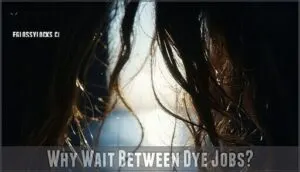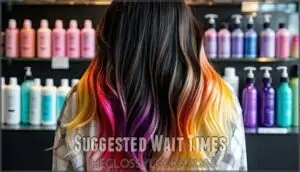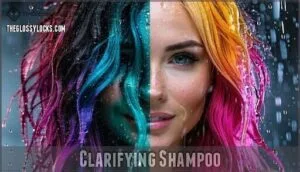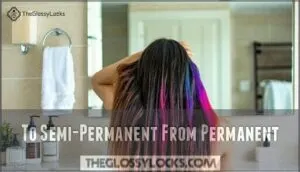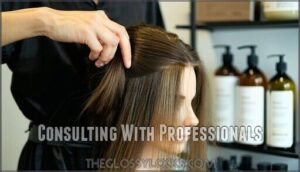This site is supported by our readers. We may earn a commission, at no cost to you, if you purchase through links.

Think of your strands like a sponge that’s already soaked – they need time to recover from chemical processing.
Dyeing too soon can turn your hair into straw, cause breakage, or create muddy colors that’ll have you hiding under hats.
If you’re dealing with a color disaster, resist the urge to fix it immediately. Your hair cuticles need time to close and strengthen. The exact timing depends on your hair’s condition and what went wrong the first time around.
Table Of Contents
- Key Takeaways
- How Soon Can I Redye My Hair?
- Why Wait Between Dye Jobs?
- Suggested Wait Times
- Dyeing Too Soon – The Risks
- Quick Fixes for Dye Disasters
- To Semi-Permanent From Permanent
- Never Dye Twice in One Day
- Consulting With Professionals
- Frequently Asked Questions (FAQs)
- How soon can I dye my hair again to fix it?
- Can I dye my hair twice in 2 days?
- How soon can I recolor my hair if I don’t like it?
- How long should you wait in between hair dye sessions?
- Can I dye wet or damp hair?
- Does hair texture affect dye waiting periods?
- How does pregnancy impact hair dyeing safety?
- Will swimming affect freshly dyed hair color?
- Can medications interfere with hair dye results?
- Conclusion
Key Takeaways
- You should wait at least two weeks before dyeing your hair again, though four to six weeks is ideal for damaged hair to properly recover from chemical processing.
- You can’t dye your hair twice in one day or within 48 hours without risking severe breakage, chemical burns, and permanent damage to your hair’s structure.
- You can use gentle fixes like clarifying shampoo or semi-permanent dye immediately after a color disaster, but avoid harsh chemical treatments until your hair recovers.
- You’ll get better results when you’re patient and let your hair cuticles close and strengthen between dye sessions, preventing muddy colors and brittleness.
How Soon Can I Redye My Hair?
The timing for re-dyeing your hair depends on several factors, including your hair’s current condition, the type of dye you used, and what went wrong with your color.
Generally, you’ll need to wait at least two weeks before applying new color, though damaged hair may require four to six weeks of recovery time.
If Your Color is Too Brassy
When your hair turns brassy after dyeing, you can tackle this issue in just 1-2 weeks.
Don’t let brassy tones ruin your color – quick fixes are just weeks away!
Purple shampoo works wonders for blonde brassiness, while blue shampoo handles orange tones.
A demipermanent toner provides longer-lasting results than toning shampoo alone.
For serious neutralizing brassiness situations, correcting undertones with professional consultation guarantees you won’t make things worse through guesswork.
If Your Box Dye Failed
When your DIY disaster recovery goes sideways, resist the urge to immediately fix those hair dye problems.
Wait at least two weeks before dyeing hair again after a botched DIY attempt. Your hair needs time to recover from the chemical assault.
Professional intervention costs more upfront, but prevents further damage from color correction urgency. If you’re dealing with underlying pigment issues, a stylist can assess whether your strands can handle another round or need extended healing time before future dye choices, considering the need for professional intervention.
If You Dyed It Too Dark
Panic sets in when you look in the mirror and realize your hair turned out darker than expected. Don’t worry—you’re not stuck with midnight black when you wanted chocolate brown.
Color removal takes patience and the right approach to avoid turning your hair into straw. Wait at least four weeks before attempting any lightening options. Your hair needs time to recover from the chemical processing.
During this waiting period, clarifying shampoo can gradually lift some artificial color, lightening your shade by one or two levels.
Here are your safest lightening options:
- Use clarifying shampoo weekly to slowly fade dark color
- Apply semi-permanent dye in a lighter shade after the waiting period
- Deep condition regularly to maintain hair health during color correction
- Consider professional help for dramatic hair color changes
- Use toner after lightening to achieve your desired shade
Professional hair color correction specialists understand how different dyes interact and can safely guide your hair color changes. They’ll assess your hair’s condition and recommend the best approach for damage control while achieving your goal color.
To Strip Out Color
When color stripping becomes necessary, you’re dealing with serious business.
Hair stripping products and bleach can effectively remove unwanted color, but they’re harsh on your strands. DIY risks include severe bleach damage and unpredictable results that could leave you worse off than before.
Professional removal is your safest bet – colorists know how to minimize damage while achieving better results. If you attempt color stripping at home, wait at least two weeks before re-dyeing to allow recovery time.
Before stripping, consider using a hair color remover for a less damaging process. Focus on rebuilding hair health with deep conditioning treatments before your next color adventure.
Why Wait Between Dye Jobs?
Patience isn’t just a virtue when dyeing hair again—it’s essential for maintaining hair health.
Your strands need time to recover from chemical reactions that occur during the coloring process. Rushing into another dye job can lead to serious hair damage from dyeing, compromising both color longevity and overall hair condition.
Here are three key reasons for proper hair dye intervals:
- Damage Prevention: Frequent dyeing weakens hair structure, causing breakage and brittleness that’s often irreversible.
- Scalp Recovery: Your scalp needs time to heal from chemical exposure and restore its natural protective oils.
- Chemical Reactions: Overlapping dyes can create unpredictable color results and increase hair dyeing frequency risks substantially.
Suggested Wait Times
Timing your next color session depends on several key factors that directly impact your hair’s wellbeing. Your hair health serves as the primary guide—damaged strands need more recovery time than healthy ones.
The dye type you’ve used also matters substantially, as permanent formulas require longer intervals than semi-permanent options.
Here’s what professionals recommend for hair dye intervals:
Color-depositing conditioner: No waiting period needed
Semi-permanent dye: Wait one week minimum
Demi-permanent dye: Allow two weeks between applications
Permanent dye: Wait at least two weeks, preferably four
Bleach treatments: Always wait two weeks minimum
Your damage level determines whether you should extend these timeframes. Hair that’s already compromised needs four to six weeks for proper recovery.
Consider your hair growth rate too—faster-growing hair handles more frequent touch-ups better. Dramatic shifts require longer wait times than subtle adjustments.
Always prioritize hair color wait time over quick fixes. To avoid damage, consider that you should wait at least one month between bleaching sessions.
Dyeing Too Soon – The Risks
Rushing back to the salon or reaching for another box dye can turn your hair nightmare into a complete disaster.
Patience saves your strands—chemical overload turns bad hair days into hair disasters you can’t undo.
Dyeing hair too soon creates a domino effect of problems that’ll make you wish you’d waited.
Hair breakage becomes your new reality when chemicals attack already weakened strands.
You’ll notice more hair in your brush, shorter pieces snapping off, and that dreaded straw-like texture.
Color build-up happens when you layer dye on dye, creating muddy, artificial-looking results.
Your hair can’t handle the chemical overload, leading to uneven tone that screams "DIY gone wrong."
The worst part?
Cuticle damage from over processed hair becomes permanent.
Once those protective scales are destroyed, your hair loses its ability to retain moisture and shine, leaving you with dull, brittle locks that resist styling.
Chemical reactions between products can cause scalp irritation, burning, and even allergic responses you weren’t expecting.
Quick Fixes for Dye Disasters
When your hair color goes wrong, you don’t always need to wait weeks before taking action.
There are gentle methods you can try right away to fix minor color disasters without causing major damage to your hair.
Clarifying Shampoo
When your hair color turns out too dark, clarifying shampoo can rescue you from a dye disaster.
This powerful cleanser strips residue and artificial pigments from over processed hair, lightening your color by one shade without causing hair damage. The shampoo ingredients work through gentle chelation, making it safer than harsh chemical strippers while you wait for professional correction.
You can find shampoo products online if you’re running low.
Here are clarifying benefits you’ll experience:
- Residue removal from previous hair dye applications
- Color fading that reveals more natural tones
- Usage frequency flexibility for gradual lightening
- Hair color correction without additional processing
- Damage prevention compared to bleaching treatments
Henna Gloss
While clarifying shampoo strips unwanted tones, sometimes you need a gentler approach that adds color back. That’s where henna gloss comes in as your hair’s best friend during the hair dye waiting period.
This natural remedy combines henna powder with conditioner, creating a less intense treatment than full-strength henna. You’ll get Henna Gloss Benefits like strengthening and smoothing without the commitment. The Henna Gloss Recipe is simple: mix equal parts henna and your favorite conditioner.
Here are key Gloss Application Tips:
- Apply mixture evenly through damp hair
- Leave on for 1-2 hours for ideal results
- Rinse thoroughly with lukewarm water
- Deep condition afterward for extra softness
Henna Color Options include rich reds, warm browns, and deep blacks. You can explore various henna products for best results. Unlike chemical dyes, you can safely repeat this process during your hair color rest period without damaging your strands or disrupting your dyeing hair schedule.
To Semi-Permanent From Permanent
After a permanent hair color disaster, switching to semipermanent dye offers excellent damage mitigation while you plan your next move.
This gentler option won’t penetrate deeper into already stressed hair, allowing for gradual progression and color fading over 4-12 washes.
You can redye with semipermanent immediately since it conditions while coloring, making it perfect for covering botched permanent hair color jobs.
| Benefit | Semi-Permanent | Permanent |
|---|---|---|
| Hair Damage Risk | Minimal | High |
| Root Blending | Excellent | Difficult when damaged |
| Even Application | Forgiving | Requires precision |
Never Dye Twice in One Day
While switching from permanent to semi-permanent dye offers flexibility, you shouldn’t redye your hair twice in one day under any circumstances. This practice creates Immediate Damage Risks that can permanently alter your hair’s health.
Your hair needs a proper waiting period between applications to recover from chemical processing. Double dyeing in a single day leads to serious consequences.
- Brittle, damaged strands that break at the slightest touch
- Scalp Chemical Burns from excessive chemical exposure
- Hair Structure Impact causing coarse, straw-like texture
- Color Result Instability producing muddy, uneven tones
- Professional Intervention Needed to repair severe damage
The hair dye frequency should never exceed manufacturer recommendations. To avoid damage, consider semi-permanent dye options. Your hair needs rest after dye applications to maintain its integrity. Even if you’re unhappy with results, wait at least two weeks before attempting corrections to prevent irreversible hair damage.
Consulting With Professionals
Professional guidance transforms your hair color journey from guesswork to science. A stylist consultation benefits you by evaluating damage levels and creating a personalized dye schedule that protects your strands.
Hair professionals assess porosity, previous treatments, and scalp health to recommend safe intervals between sessions. Professional color correction prevents costly mistakes while damage assessment advice guarantees long-term hair health.
Trichologists can evaluate severe cases requiring specialized care. To avoid excessive damage, it’s best to understand how bleaching works.
| Service Type | Wait Time Recommendation |
|---|---|
| Color Correction | 2-4 weeks minimum |
| Routine Touch-ups | 4-6 weeks standard |
| Damage Repair | 6-8 weeks recovery |
Frequently Asked Questions (FAQs)
How soon can I dye my hair again to fix it?
You can fix hair dye mistakes after waiting at least two weeks, but damaged hair needs four to six weeks.
Your hair’s health determines the timeline—rushing risks breakage and uneven color results.
Can I dye my hair twice in 2 days?
Hair damage increases by 300% when you dye twice within 48 hours.
You shouldn’t dye your hair twice in two days – it’ll cause severe breakage and chemical burns.
Wait at least two weeks between sessions.
How soon can I recolor my hair if I don’t like it?
You can recolor your hair immediately if you used semi-permanent dye.
But wait at least two weeks for permanent color.
Your hair needs recovery time to prevent damage, breakage, and unpredictable results.
How long should you wait in between hair dye sessions?
Want to keep your hair healthy while switching up your color?
You’ll need to wait at least two weeks between dye sessions, though four to six weeks is safer for damaged hair.
Can I dye wet or damp hair?
You shouldn’t dye wet or damp hair because water dilutes the color, preventing proper penetration and adhesion.
Towel-dry your hair first, leaving it slightly damp but not dripping for ideal color results.
Does hair texture affect dye waiting periods?
Yes, your texture matters when timing re-dye sessions.
Fine or damaged strands need 4-6 weeks between colors since they’re more fragile.
Thick, healthy hair can handle re-dyeing after just 2 weeks without major damage.
How does pregnancy impact hair dyeing safety?
Like walking on eggshells, you’ll want extra caution during pregnancy. Most experts suggest avoiding hair dye in your first trimester, then choosing ammonia-free options afterward. Your baby’s safety comes first.
Will swimming affect freshly dyed hair color?
Swimming can definitely fade your freshly dyed hair color faster than you’d like.
Chlorine strips color molecules, while salt water opens cuticles and lets pigment escape.
You’ll notice fading within days of regular pool sessions.
Can medications interfere with hair dye results?
Forewarned is forearmed when mixing meds and hair color.
Certain medications can interfere with your dye results. Antidepressants, cholesterol drugs, and chemotherapy treatments may cause unpredictable color outcomes or buildup.
Some drugs are known to cause drug-induced hair changes, which can be a significant issue, making forewarned and forearmed crucial in this context.
Conclusion
Ironically, the best hair advice is often about what not to do, and rushing into another dye job tops that list.
Remember, knowing how long should you wait before dyeing your hair again isn’t just about timing—it’s about preserving your hair’s integrity.
Whether you’re fixing a disaster or switching shades, patience protects your strands from damage.
Your hair will thank you for waiting those vital weeks, and you’ll achieve better, longer-lasting results every time, which is why waiting is crucial.
- https://www.ncbi.nlm.nih.gov/pmc/articles/PMC4387693/
- https://theshade.com.au/blogs/how-to-avoid-the-colour-banding-effect/
- https://www.quora.com/profile/Erinn-Baur
- https://www.wella.com/international/wella-magazine/how-hair-coloring-works
- https://www.healthline.com/health/beauty-skin-care/over-processed-hair

